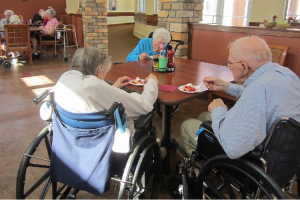
16 Feb How should the elderly home be?
Houses must be adapted to the needs of those who reside in them. A shared apartment between students is not the same as a family home with small children. In the same way, the elderly home must take into account their possible mobility limitations, facilitate accessibility and prevent possible accidents.
And this applies both when it comes to reforming the house of a lifetime and for those who, having reached a certain age, decide to look for a new property to enjoy this vital stage. Home adaptation is so important that in some countries –especially in the United States– there is already an entire specialized professional field: the Certified Aging-in-Place Specialists (CAPS), experts in evaluating and recommending modifications in the elderly homes of greater.
Everything At Hand, But Without Hindering The Passage

Good lighting is essential to avoid falls or stumbles. Plugs and switches must be easily accessible and located in the most necessary places: next to the head of the bed, at the ends of a corridor, or at the beginning and end of stairs. In addition, they must be at a suitable height to be able to operate them without forcing the body.
It is also important to avoid extension cords or loose cables (they can be fixed to the wall if necessary) and the presence of children’s toys or pets in passageways. In the same way, auxiliary furniture that is not essential in corridors or narrow areas can be eliminated.
It Is Better To Prevent
To prevent accidents, it is advisable to fix the shelves to the wall and choose furniture with rounded edges, which will prevent serious injuries in the event of a trip. The floors must be smooth and non-slip and it is suggested to avoid carpets or, failing that, fix them with adhesives to prevent them from moving. If there are steps, such as those leading to a terrace, for example, they must be clearly visible and, if necessary, have elements that help to cross them.
Safe Bathroom
The bathroom is probably one of the areas that require greater adaptation for older people. It is better to have a shower than a bathtub, with as few steps as possible and non-slip mats. Grab bars both in the shower and next to the toilet are essential to facilitate movement and prevent falls.
A Nice Lounge
For many older people, the living room becomes the room in which they spend the most hours at the end of the day. It is advisable to take advantage of natural light whenever possible and have good lighting at all hours. The distribution of the furniture must facilitate the passage. And adapt to the tasks that are carried out in this room. For people with mobility problems, an armchair is better than a sofa. With armrests and preferably neither too low nor too soft, so that getting up is easier.
Everything By Hand In The Kitchen
In the kitchen, you can opt for shallow sinks and shower-type faucets so as not to force postures. It is important to avoid the use of very low or very high shelves. Everything must be at an easily accessible height. Vitroceramic stoves are safer to avoid burns and allow you to slide pans and casseroles with little effort. Some models also have timer systems and automatic shutdown. A cart with wheels can be a good ally to transport kitchenware or heavy pots.
Telephone
Senior housing adaptability experts recommend having a cordless phone that they can take with them anywhere in the house. There are adapted models with large keys and with the possibility of memorizing frequent or emergency numbers.
The Empty Rooms
Many elderly homes have more rooms in their homes than they currently use on a daily basis. If they are going to be closed, the central heating or air conditioning can be turned off to avoid unnecessary consumption. They can also be converted as a space for your hobbies: from a painting studio to a large table for puzzles, a library with a good chair to read, or a place to organize your collections.
The most important thing, in any case, is that all these changes are made in accordance. With what is most appropriate for each person. And always with the aim of maintaining and improving the quality of life. In their own elderly home as much as possible.
You may also be interested in Homecare: how to help your loved ones grow aging at home



Sorry, the comment form is closed at this time.